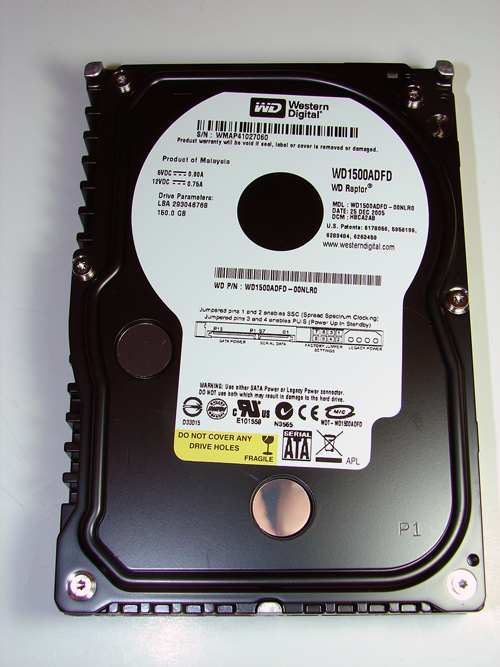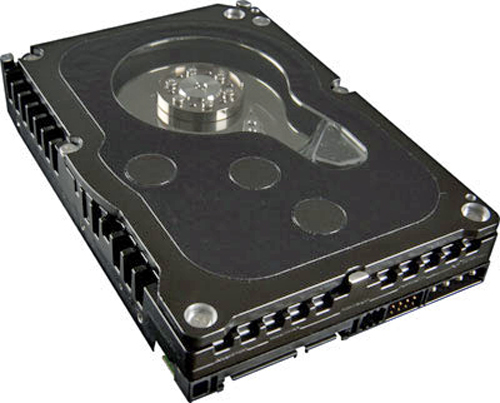Western Digital WD1500ADFD: King Raptor
by Gary Key on February 8, 2006 1:30 AM EST- Posted in
- Storage
"It takes a long time to bring excellence to maturity."
This maxim by improvisatore and Latin writer Publilius Syrus expresses our thoughts on the third-generation Raptor from Western Digital. This latest release in the Raptor series comes almost three years after the original Raptor WD360GD was launched.The original Raptor was launched as the WD360GD in March of 2003 with an enterprise level 10,000 RPM spindle speed, SATA interface, 8-Megabyte buffer, 5.2 millisecond read seek time, and a single-platter design featuring 36 gigabytes of storage. While it shined in single-user performance, the drive did not fare well against its SCSI based competitors in the enterprise server market for which it was designed. It's already small size and complete lack of command queuing abilities delivered performance that was not on par with the SCSI based drives in the critical multi-user applications. However, due to the lack of entry level SCSI drives, a growing interest in SATA components, and a very avid computer enthusiast market, the drive was able to succeed until its replacement arrived.
The next version of the Raptor was launched as the WD740GD in December of 2003 and boasted several needed enhancements. These enhancements included the addition of another platter that increased the capacity to 74-gigabytes, 4.6 millisecond read seek time, a FDB based motor to address noise concerns, and ATA-4 tagged command queuing. While TCQ was a welcome addition and certainly improved the drive's I/O operations, it still was not a match for most SCSI drives in the enterprise market. This was primarily due to a lack of SATA controllers that fully supported TCQ and firmware as mature as the SCSI competition.
However, this drive was consistently and, in some cases, continues to be one of the fastest single-user performance drives available. The computer enthusiasts flocked to the drive due to its performance advantages, but the drive continued to have limited success in the enterprise server market. In a nod to the success of the drive in the computer enthusiast market and acceptance of its importance, Western Digital offered the drive in retail stores for a short time. Over the course of the last two years, the drive has been enhanced with minor revisions with the latest version, WD740GD-00FLC0, receiving tweaks that have improved its performance mainly in single-user applications. Although the drive's capacity is dated compared to the newer 300~500 gigabyte SATA drives, its price-to-performance factor is now attractive.

Like the recently released Caviar RE2 WD4000YR drive that is based on the latest Raptor platform, this drive supports Time Limited Error Recovery and Rotary Acceleration Forward Feed operations. TLER allows the drive to signal the RAID host adapter in the event an error recovery process has exceeded time out parameters. This prevents false drive dropouts on the host adapter when utilizing RAID level 1 or above configurations. Although TLER is disabled by default, a utility might be available in the future from Western Digital to enable TLER. RAFF is an electronics feature that senses rotational vibration in a multi-drive setup and then compensates for it by controlling the drive head location. This feature is designed to keep read and write operations consistent, thus avoiding time consuming retries by the drive that could impact performance.

Thus, Western Digital will have two different models of basically the same drive in the market place. The WD1500ADFD will be primarily targeted as an entry-level alternative in the enterprise market with the WD1500AHFD being targeted to the computer enthusiast and gaming user.
The Raptor X model differs cosmetically from its parent by offering a transparent cover over the spindle and platter section of the drive. The cover was designed from a special grade of crystalline polycarbonate with a unique ESD-dissipative coating. The combination of this cover and the conductive frame design will protect the read/write heads from potentially damaging static discharge.
Let's see how the newest Raptor performs against other SATA based drives.










51 Comments
View All Comments
Gary Key - Wednesday, February 8, 2006 - link
Believe me, Purav cannot wait to start testing this drive in a RAID setup.feraltoad - Wednesday, February 8, 2006 - link
It would be great if you could include a comparison of the all 3 raptors in Raid 0. I have a 36gb Raptor and have often wondered if 2 in raid 0 would be as fast as 1 74gb raptor. Esp. now w/newer versions.Rapsven - Wednesday, February 8, 2006 - link
The content was very informative, and as a whole, the article was very well done. But jesus christ, dude, opening your articles with quotes ticks me off to no end.rjm55 - Wednesday, February 8, 2006 - link
Perhaps the quotes at the front of Gary's reviews will give you a repetoire that will include words that can be substituted for Dude. If you hate the quote just skip the first few sentences and you will not have to be bothered by the quotes.Personally I like them - the quotes set the reviews apart. It's sometimes nice to have a little education with my favorite hobby.
Gary Key - Wednesday, February 8, 2006 - link
Is it the quote itself or just the fact there is one? I would appreciate some honest feedback on the subject. I like the quote as it sets the tone for the article but I also realize it really is not needed. :-)
Rolphus - Thursday, February 9, 2006 - link
I love the quotes. In particular, this one stuck in my mind, and provided an incredibly simple, single-sentence "hook" into the review which summed it up perfectly. I'd vote to keep them.johnsonx - Wednesday, February 8, 2006 - link
I like the quotes. It makes me think of Chairman Kaga on Iron Chef (the original Japanese show, not the new Iron Chef America).Seriously Gary, keep the quotes.
fb0252 - Wednesday, February 8, 2006 - link
newbie q: the review uses the term "single user" recommending turning off native command queing in single user setting as opposed to multi user. i have a pair of wd1500s on my floor ready to be installed in our office system in Raid 0. One person at a time uses the computer but we frequently "multi-ask". do we turn of NCQ to get faster speeds in this sitaution--am I a "single user" on this computer, though much of our use is multi-asking--six programs at once e.g. doing multiple tasks.Gary Key - Wednesday, February 8, 2006 - link
Hi,I am assuming your applications will be general office and the machine is not being setup as a local server. If so, turn off NCQ. It it really meant at the server-level where you have highly random and concurrent requests. I would not go with RAID 0 for an office environment as you are playing with fire in regards to data reliability. Setup you system in RAID 10 if it supports it.
Thanks....
Gary Key - Wednesday, February 8, 2006 - link
We need an edit function. "Setup your system in RAID 10 if it supports it."